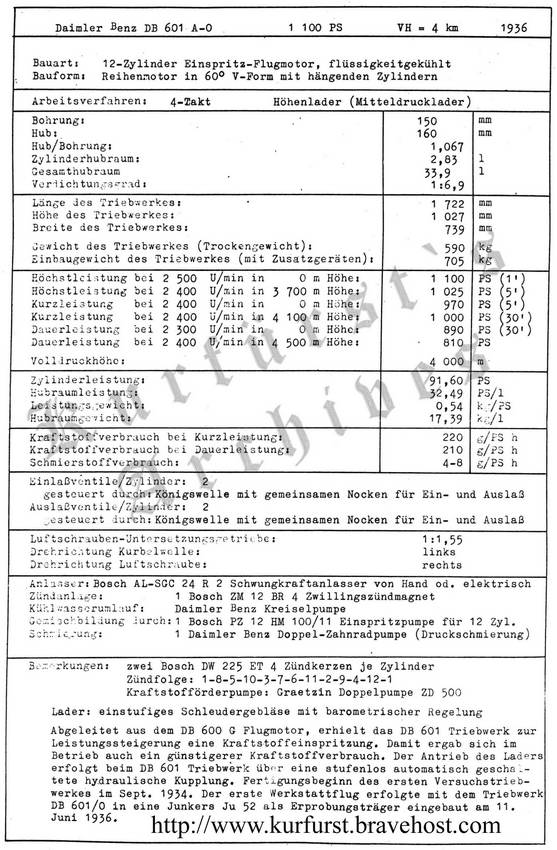Quote:
Originally Posted by MiG-3U

The facts:
1. Prototype aircraft V15a, tested well before production started
|
Fact: report says aircraft is identical to production E-1.
Quote:
Originally Posted by MiG-3U

2. Tested speed 493kmh at altitude of 440m, gives 485kmh at 0m
|
Fact: MIG 3U misrepresentats the report, which states:
Erflogene Geschwindigkeit 493 km/h, auf Normaltag und Garantileistung umgerechnete Geschwindigkeit 498 km/h im 0 m.
They have flown 493kmh at altitude of 440m, which was not yet corrected for German Standard Day conditions or the Guaranteed output of the engine. Bench tests confirmed engine was developing 45 PS less than it should have.
Quote:
3. The supercharger has two fixed speeds:
- boden- and hohenlader are claimed and the optimal change altitude is determined
- manifold pressure drops above the FTH of the bodenlader, until hohenlader is set on
- the speed test confirms that the supercharger has two fixed speeds
|
Nope.
Fact: Boden and Hohenlader are just generic names for MS and FS speeds, present on all DB 601/605/603.
The supercharger has two . US trials of captured Bf 109E, later Rechlin trials of Bf 109G-6, G-14 also run with fixed supercharger speeds, something which is easily done on the DB 60x series with hydraulic coupling by bypassing the barometric control.
Quote:
Originally Posted by MiG-3U

- according to Flugmotoren und Strahltriebwerke by Kyrill von Gersdorff, Kurt Grasmann, Helmut Schubert the first order of the DB601 was the pre-series of 150 motors, A-0 ie Baureihe A (carburator engine with fixed speed supercharger), so based on engine number of 140, the V15a had one of these instead a A-1. The hydralic clutch came later with the Baureihe B along with fuel injection.
|
Nope.
DB 601A-0.
"Gemischung durch: 1 Bosch PZ 12 HM 100/11
Einspritzpumpe für 12 Zyl."
"Lader: einstufiges
Schleudergeblaese mit barometrischer regelung"

Quote:
Originally Posted by MiG-3U

It's not a test, just a piece of paper, no test data nor kenblats of production planes support 500km/h at sealevel.
|
Nope. French trials for example with Bf 109E-3 WNr. 1304. (DB 601A-1, so lower power at 1,3ata) show 495 kph at about 500 meter altitude.
http://kurfurst.org/Performance_test...09EWNR1304.jpg
Quote:
|
Everything else is around 460-470km/h including swiss planes with the 601Aa.
|
All figures match the V15a performance using Höhenlader well, indicating the tests
"Everything else", well.
WNr. 1774. 498 kph, E-1, "DB 601A", 1,35 ata. 1060 PS.
WNr. 1791. 475 kph, E-1, DB 601A-1, 1,3ata 990 PS, ie. 70 PS less power. "figures are not corrected for guaranteed engine output"
WNr. 1792. 467 kph, E-1 DB 601A-1, 1,3ata 990 PS, ie. 70 PS less power. "figures are extrapolated graphically to 0m" and "figures are not corrected for guaranteed engine output"
WNr. 1304, ca. 485 kph, E-3, DB 601A-1, 960 Hgmm (ca. 1,3 ata). 990 PS, ie. 70 PS less power. With estimated position error curves: +/- 15 kph on speed.
WNr. 2404, 464 kph, E-3, DB 601Aa, probably 1,35ata. Conditions unknown. Curves clearly show single speed supercharged performance with no appearant hydraulic curveture. Figures closely match WNr. 1774. Höhenlader performance (extrapolating to about 460 kph at SL)
Calculating the speed of the the Spitfire I at +12lbs the same way as done in the V15A report:
Density at sealevel: 1.225 kg/cubic meter
Power at sealevel at +6.25lbs: 880hp
Power at sealevel at +12lbs: 1180hp
Speed at sealevel at +6.25lbs: 280mph
r = ((1180/880)*(1.225/1.225))^(1/3) = 1.103
V0 = 280mph * 1.103 = 309mph = 497kmh
However, that is a crude, unaccurate and partially wrong way to calculate it.
Quote:
|
The only speculative but logically correct part in my post is the size of the oil cooler, and it was there only because you asked it. The rest are facts.
|
As shown above, they are not facts but misrepresentation of the facts.
Your theory is basically this. Messerschmitt built a prototype for the Bf 109E series, which achieved around 500 kph with the the engine cowling still unpainted, without fuel injection and without a multi speed supercharger, which (then appearantly the Americans got hold somehow of another Bf 109E and oddly tested it the same way as the Germans theirs...

) . They have noted in their report that due to time constraints, they could not yet fit the proper exhausts and air intake, so "further increases in performance are possible".
Then they supposedly went on improving it with a oil cooler of the size of an elephant, that chopped down 40 kph (!!!


) from top speed, but strangely enough only at low altitude

, they added direct fuel injection which probably made the engine even weaker. Happy of good days work, and that they achieved no less than 40 kph speed loss, they decided to put that new version into production. The legal and financial department went nuts too, and decided to give legal guarantees for reaching a performance that according to you, was impossible to achieve. Save for a few odd examples that landed in French, Swiss hands which matched V15a figures finely.
Extremely likely, yes.
Any observations on the "prototype" Bf 109E overlayed with the Swiss trials of WNr 2404?